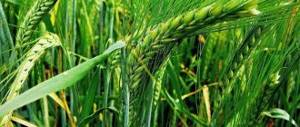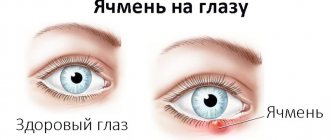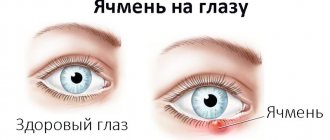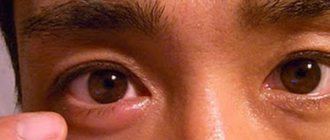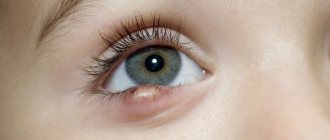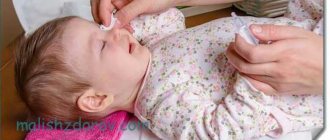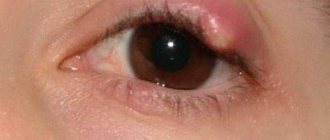When the sebaceous glands become blocked in the eyelid area, cold barley occurs. The condition is accompanied by discomfort when blinking, the appearance of a round formation filled with purulent exudate. To prevent complications, it is recommended to consult a doctor who will diagnose, prescribe medications or effective folk remedies, perform surgery if necessary, and also give preventive recommendations.
How and why does stye occur?
The main cause of the disease is lack of personal hygiene.
A chalazion occurs when a regular stye hardens and is characterized by an inflammatory formation at the edge of the cartilaginous tissue of the eyelid, followed by hardening. The pathological process occurs due to blockage of the sebaceous (meibomian) gland and accumulation of secretions. A stye on a child’s eye is formed due to infection with dirty hands. In adults, the disease is provoked by the following factors:
- oily skin type;
- prolonged exposure to the cold;
- incorrect use of contact lenses and improper care of them;
- endocrine disorders;
- decreased immunity;
- use of low-quality or expired cosmetics;
- frequent ARVI;
- lack of vitamins and microelements;
- eating a lot of sweets, which increases the oiliness of the skin;
- disruption of the digestive system;
- Carrying out cosmetic procedures with contaminated instruments.
Causes
There is no exact underlying cause that contributes to the development of chalazion. However, doctors have identified indirect reasons that can trigger the appearance of hardened barley:
- tendency to colds, viral diseases, as well as hypothermia;
- repeated diseases associated with inflammation of the eyelid (for example, blepharitis, conjunctivitis);
- stye caused by bacterial infection;
- oily skin;
- pregnancy (hormonal imbalance);
- dysfunction of the thyroid gland (hormonal imbalance);
- diabetes (hormonal imbalance);
- transition period in adolescents (hormonal imbalance);
- violation of personal hygiene rules (sleeping with makeup, touching eyelids with dirty hands);
- weakened immune system;
- complications when wearing contact lenses;
- diseases of the gastrointestinal tract;
- farsightedness;
- stress;
- allergy.
How does the pathology manifest itself?
At the initial stage of the disease, it becomes painful for a person to blink.
Unlike ordinary barley, in which suppuration and breakthrough occur, cold barley hardens and takes on the appearance of a soft, round tumor. The disease has 3 stages of development. How the signs differ is shown in the table:
| Stage | Symptoms |
| Initial | Mild pain when blinking or touching the eyes |
| Slight local redness at the site of future formation | |
| Average | Increased pain |
| The appearance of a small formation | |
| Redness of the eyelid skin | |
| Feeling of a foreign body inside under the eyelid | |
| Yellowish contents are visible on the vesicle under the skin | |
| Heavy | Barley breakthrough occurs |
| Seal of the formation, if it has not ruptured | |
| Significant increase in size | |
| Eyelid deformity | |
| Increased pressure on the eyeballs |
Stye on the eye
Quick treatment of stye on the eye in 1 day at home Stye on the eye is considered a fairly common ophthalmological disease, which is an inflammatory process of the sebaceous gland or hair follicle near the root of the eyelash.
The disease manifests itself in the form of redness and a purulent tubercle. The appearance of stye is accompanied by many unpleasant sensations: itching, the sensation of a foreign object in the eye, pain. And this nuisance does not add any attractiveness. In this regard, the question of getting rid of this scourge becomes urgent.
Barley is often treated at home, using various folk remedies. This article will discuss the most effective of them.
What it is?
Stye on the eye is a common ophthalmological disease in which the sebaceous gland or hair follicle in the eyelash area becomes inflamed, resulting in swelling.
Styes (see photo) look like a lump or redness that causes discomfort, itching and pain.
Causes of stye
There are a sufficient number of causes of stye - from poor hygiene to reduced immunity and parasites. Here are some of them:
- the main reason is Staphylococcus aureus, which has penetrated into the hair follicle of the eyelash;
- disruption of metabolic processes in the body;
- reduced immunity (the body's defenses are reduced);
- stress, mental and physical stress, lack of rest;
- vitamin deficiency;
- violation of personal hygiene standards, poor-quality cosmetics;
- diseases of the digestive tract;
- diabetes mellitus, thyroid dysfunction;
- hypothermia, colds;
- chronic infections, helminthic infestations, heredity.
There are 2 forms of infectious disease:
- External stye is the formation of an abscess on the outer side of the eyelid near the eyelashes. This is the most common type (90% of cases).
- Internal styes appear due to the penetration of bacteria into the meibomian glands located in the middle tissues of the eyelid. This type is sometimes complicated by chalazion, a chronic inflammation of the eyelid.
Barley is not a contagious disease and most often occurs in women. This is due to the fact that women more often touch their eyes with their hands, which are not always clean, and use cosmetics. When using contact lenses, the risk of getting stye increases.
Is stye contagious?
When stye is discovered on the eyelid, many people have a question: “Is it contagious and is the infection transmitted through contact with a patient?” It is safe to say that barley does not pose any danger to others.
The causative agents of the disease are bacteria that are not transmitted to humans either by airborne droplets or by contact with them. Infection is possible only in the rare event that a healthy person gets pus containing bacteria on the skin around the eyes, but this infection option is unlikely. [adsen]
What are the symptoms?
If you have a stye on your eye, you will immediately see redness, feel pain and swelling on the eyelid. In addition, it may appear that a foreign body has entered the eye. In many cases, stye causes increased tearing.
The disease can be external and internal. In the first case, a yellow abscess forms closer to the edge of the eyelid, touching which is accompanied by pain or warmth.
If the stye is internal, redness with a yellow spot develops, located on the inner surface of the eyelid. The skin around it is inflamed.
In most cases, external stye develops quickly, unlike internal stye, and is less painful. Some people may suffer from the disease regularly, while others experience it only a couple of times in their lives. In the first case, it is worth undergoing an examination to identify chronic or systemic diseases. Sometimes several barleys may pop up.
What does stye look like on the eye: photo
The photo below shows how the disease manifests itself in humans.
Complications
Due to untimely treatment, improper treatment, or attempts to remove pus on your own, barley can cause more serious pathologies:
- phlegmon of the orbit;
- meningitis;
- septicemia;
- thrombosis of the cavernous sinus.
This is why it is important not to self-medicate, even if the patient is confident in the diagnosis.
How to quickly and easily cure stye on the eye?
Medicinal drugs are most often used when the barley is ripe or has broken through. Typically, the standard treatment regimen for stye includes antibacterial drops or antibacterial ointments. In complicated cases, the ophthalmologist prescribes oral antibiotics.
List of effective eye drops:
- Levomecitin (an antimicrobial agent that destroys and prevents the proliferation of rickettsia, mycoplasma and others);
- Albucid (has bacteriostatic properties, based on sudfacetamide);
- Tobrex (an antibiotic containing an aminoglycoside);
- Tsiprolet (antibiotic, has anti-inflammatory effect, has side effects).
Also, to cure the resulting eye inflammation, ointments are prescribed:
- Vishnevsky ointment (a bandage is applied to the reddened skin, which must be secured with a band-aid and worn for several hours);
- Tetracycline (used from the initial stage until the opening and removal of purulent contents);
- Floxal (the ointment is applied under the lower conjunctival sac, then the eye is closed and the eyeballs are moved to distribute the product evenly);
- Blefarogel (contains hyaluronic acid, which cleanses the skin and mucous membrane of the eyelid, has an antiseptic and anti-inflammatory effect);
- Hydrocortisone (if the eyelid is retracted, apply ointment to the eye, the procedure should be performed 2 times a day, it is recommended to use only as prescribed by a doctor).
Before instilling drops and treating inflamed areas, you must wash your hands thoroughly so as not to introduce other possible diseases into the infected eye.
Symptoms of barley subside 1 day after starting to use antibacterial drugs (ointments or drops), the disease completely disappears in 3-5 days. Do not under any circumstances interrupt the use of medications after symptoms have decreased; adhere to the treatment period prescribed by the ophthalmologist.
Folk remedies
Internal styes on the eye can also be treated with heating, but manipulations will need to be carried out for a longer time, and instead of cauterization, lotions and compresses are used. If an abscess appears, you should stop all home treatments and turn to the medications listed above.
How to treat stye on the eye using lotions:
- Chamomile. Chamomile has anti-inflammatory and healing properties. Pour boiling water over two teaspoons of dry herb and let it brew for a while. Apply lotions to the affected eye 3-5 times a day for 7-10 minutes.
- Tea brewing. To cure barley, make a strong infusion of tea. It can be used simply to wash the eye, or dip a cotton infusion into the drink and apply it as a lotion to the sore eye. Keep compresses with tea on the eye for about 15-20 minutes, the procedure is repeated 4-5 times a day.
- Dill. Dill seeds help relieve swelling and eliminate redness in the inflamed area. Grind a couple of tablespoons of dill seeds in a mortar and add cold water (2 cups). Bring the mixture to a boil over low heat, and then cool. Using the infusion, you can wash the sore eye or make compresses based on it.
- Calendula. Prepare an infusion of calendula: pour a glass of boiling water into a tablespoon of inflorescences and infuse for half an hour. Cotton pads soaked in the infusion are applied to the sore spot.
- Aloe juice. Aloe leaves have a stretching and anti-inflammatory effect. Cut a small aloe leaf into small pieces and squeeze the juice out of them. Mix aloe juice with clean boiled water and let it brew for about 8 hours. Apply a cotton pad soaked in the infusion to the barley 3-4 times a day.
How is diagnosis carried out?
By visually examining the patient, the doctor can determine the diagnosis.
An ophthalmologist can identify cold-type stye. To make a diagnosis, a visual examination is usually sufficient, when the doctor performs palpation and listens to complaints. However, with frequent relapses or rapid growth of the tumor, diagnostic methods are recommended, such as:
- ophthalmoscopy;
- biomicroscopy;
- bacterial culture of purulent contents from the eye;
- histology of the removed chalazion (to exclude carcinoma of the sebaceous glands);
- general clinical urine and blood tests;
- blood test for glucose.
Treatment: the most effective methods
Drug therapy
The drugs must be prescribed by a doctor. Self-medication worsens the condition. Chalazion on the upper or lower eyelid can be treated with the medications shown in the table:
| Pharmgroup | Name |
| Anti-inflammatory eye injections | "Lucentis" |
| "Avastin" | |
| "Eilea" | |
| "Kenalog" | |
| "Ozurdex" | |
| Liniments | "Hydrocortisone" |
| "Dexamethasone" | |
| Yellow mercury ointment | |
| Antibacterial drops | "Tobrex" |
| "Floxal" | |
| "Tsipromed" | |
| "Okomistin" |
Physiotherapy
An additional method of treating such formations can be UHF.
It is recommended to treat cold-type stye using physiotherapeutic methods, such as:
- electrophoresis;
- UHF therapy;
- infrared irradiation;
- exposure to ultraviolet radiation;
- air shower.
The procedures have the following therapeutic effect on the elimination of chalazion:
- promote the resorption of barley;
- relieve pain and swelling;
- accelerate tissue regeneration;
- restore local metabolism;
- prevent relapses.
Surgical intervention
If conservative methods do not help, cold stye on the eye is removed through surgery. The procedure is performed under local anesthesia and consists of the following steps:
Lidocaine is used to numb the surgical site.
- Lidocaine or Marcaine is injected into the skin around the eyes.
- A window clamp is applied.
- An incision is made in the conjunctiva or skin near the organ.
- Barley is being eliminated.
Treatment with traditional methods
When using herbal remedies, you should be careful not to get them into your eyes.
To treat cold stye in children and adults, warm compresses made from heated table salt or sand are suitable. However, this method is contraindicated in the acute stage of the disease. We also recommend lotions made from aloe juice, prepared in this way:
- Take a freshly cut leaf of the plant, wash it thoroughly and squeeze out the juice.
- Dilute the resulting liquid with water in a ratio of 1:10.
- Soak a cotton swab in the product and apply to the sore spot.
Calendula infusion is used to prepare lotions.
An effective calendula lotion should be prepared as follows:
- Take 10 g of flowers and add 200 ml of hot water.
- Let it brew for 30 minutes, filter.
- Soak a cloth in the infusion and apply it to the eye.
Stye on the eye photo of what it looks like: types and stages of development of barley
How does hordeolum manifest itself, and what distinguishes it from other eye diseases? What does stye look like on the eye (photo)? The answers to these questions can be found in this article.
When the root of the eyelash hair follicle becomes inflamed, a stye forms on the eye. Scientifically, this disease is known as hordeolum. It can pop out on both the upper and lower eyelids, and can be external or internal.
The unpleasant symptoms caused by purulent inflammation are probably known to almost everyone. But many people mistakenly call other inflammatory eye diseases stye.
What does stye look like on the eye?
The painful formation is characterized by a reddened swelling in a small area of the eyelid, in the area of which pain is felt. The disease received its name for its external similarity with a well-known agricultural crop, barley grain.
You can see what stye looks like on the eye in pictures from the Internet.
Some people mistakenly believe that stye under the eye is hordeolum. It is often confused with another inflammatory disease, chalazion (chalazion). Chalazion is popularly called cold stye on the eye.
The photo shows that the external symptoms of these ophthalmic ailments are, however, very similar. Both are characterized by swelling and redness, but their presentation differs in the later stages. A cholazion remains a dense formation without an abscess inside, which is located in the inner layer of the eyelid.
How does barley manifest itself, and what are the stages and types?
The development of barley in most cases is caused by staphylococcus bacteria. The infection leads to acute purulent inflammation of the ciliary hair bulb or meibomian gland lobule.
It is customary to distinguish the following types of barley:
Internal stye . Purulent inflammation occurs inside the eye due to infection entering the meibomian glands, which are located inside the eyelid. Signs of internal stye include swelling of the eye and the appearance of a lump with a purulent sac. Such barley “ripens” more slowly, and its symptoms are much more painful.
- Meibomite is an internal stye on the eye.
- The photo shows the disease in its final stages, when the head forms.
External stye . A more common type of hordeolum. An abscess develops at the edge of the eyelid and is accompanied by inflammation and painful swelling in a certain area of the eyelid.
- After three days, a yellowish purulent top appears, which soon breaks through.
- Its contents come out.
- According to location, barley is distinguished:
- on the upper eyelid
- on the lower eyelid
- Internal stye
There are two stages in the development of barley:
- Infiltration stage. At this stage, the inflammatory process develops
- Stage of suppuration. During this period, it matures, the purulent capsule breaks through, and the contents come out.
Stye in a child
Most often, stye on the eye (photo below) “pops up” in young children whose immunity is weakened.
The signs and stages of the disease are no different from hordeolum in adults. But children, as a rule, suffer more severely from such illnesses.
At the initial stage of the disease, the area of the affected eyelid swells and redness appears. The affected area experiences severe itching. After a couple of days, the barley ripens and an abscess appears. Because of this, swelling increases significantly and redness of the conjunctiva is observed.
With a weakened immune system, stye may appear in both eyes or in one eye in several places. In severe cases, the appearance of an abscess may be accompanied by a rise in temperature to 38°C and headache.
In the last stages of the disease, the abscess opens or resolves on its own.
If within 4-5 days the abscess has not broken through and the symptoms of stye have not disappeared, you should seek help from a doctor.
Prevention
Complications after barley, as a rule, are not observed. The disease leaves no traces. With proper treatment, recovery occurs fairly quickly.
To avoid re-infection, it is important to follow the following rules:
- Strengthen immunity;
- Do not touch your eyes and face with dirty hands;
- When a stye “pops up”, you should not rub your eyes;
- Use personal hygiene products, including your own towel;
- Wash off cosmetics and monitor their expiration date; do not use cosmetics during the treatment period;
- Do not try to open the abscess yourself;
- Treat eye diseases in a timely manner
- Don't get too cold.
Prevention
To avoid frozen stye, it is recommended to carefully monitor the hygiene of your hands and face. When purchasing cosmetics and skin care products, you should check expiration dates, storage conditions and product documents. It is better to avoid dubious purchases. You also need to eat right, strengthen your immune system, and avoid hypothermia. It is strictly forbidden to touch or rub your eyes with contaminated hands. When using contact lenses, you should strictly adhere to the rules for storing and installing them.
